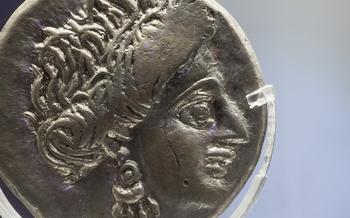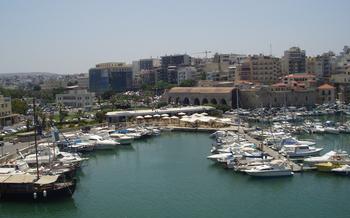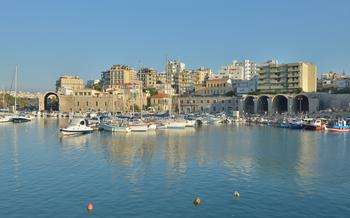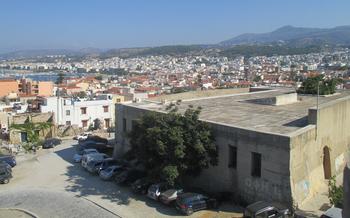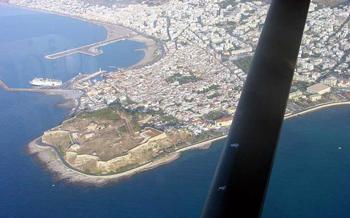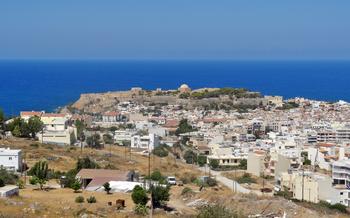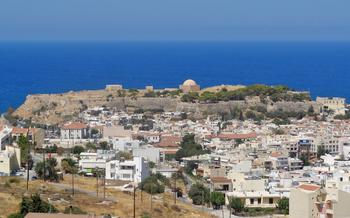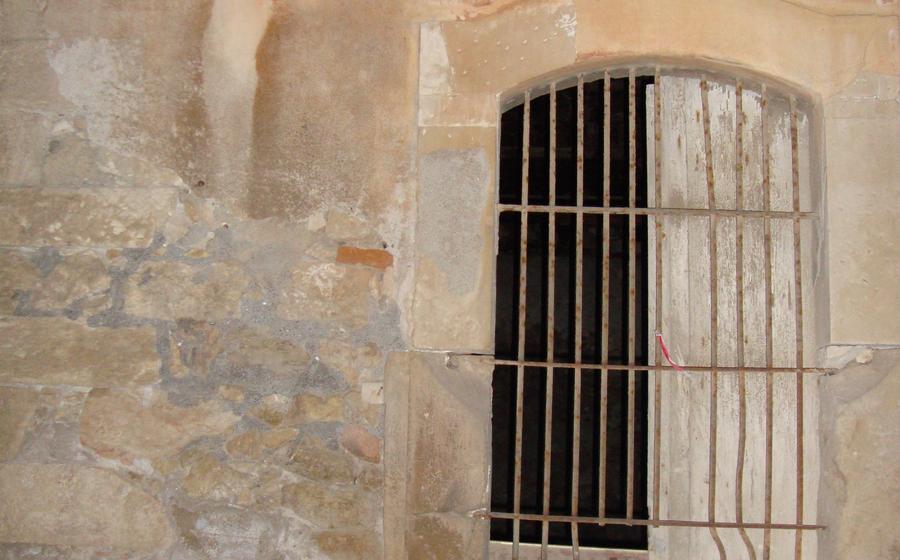
Spili Village and Lion Fountain
- The Village of Spili and its Unique Charm
- The Lion Fountain: A Symbol of Spili's Heritage
- Exploring the Village's Narrow Streets
- Discovering the Village's Rich History
- Savoring the Local Cuisine
- Visiting the Village Church
- Exploring the Village Square
- Hiking in the Surrounding Mountains
- Visiting the Archaeological Museum
- Shopping for Local Products: Embracing Spili's Cultural Treasures
- Attending a Village Festival:
- Visiting the Olive Oil Press:
- Exploring the Village's Water Mills
- Learning about the Village's Crafts
- Insider Tip: Unveiling the Hidden Oasis of Spili
The Village of Spili and its Unique Charm
Nestled at the foot of Mount Psiloritis, the traditional village of Spili exudes an undeniable charm that captivates visitors with its rich history, stunning natural beauty, and warm hospitality. Spili's origins date back to the Venetian era, and its architecture reflects this heritage with stone-built houses, narrow streets, and arched doorways. The village's strategic location has made it a significant trading hub throughout the centuries, contributing to its vibrant atmosphere and diverse cultural influences. Surrounded by lush vegetation and flowing waters, Spili offers a serene escape amidst the natural wonders of Crete. The welcoming smiles and friendly interactions with the locals add to the village's allure, creating a truly immersive experience for those seeking an authentic taste of Cretan culture.
The Lion Fountain: A Symbol of Spili's Heritage
The Lion Fountain stands as an iconic symbol of Spili's rich history and cultural heritage. This intricate and majestic fountain is a testament to the village's Venetian past and serves as a gathering place for locals and visitors alike. Carved from a single block of marble, the fountain features a majestic lion's head, its fierce gaze adding to the fountain's captivating presence. The water that flows from the lion's mouth symbolizes the lifeblood of the village, a constant reminder of the importance of this precious resource.
The fountain's construction dates back to the 16th century, during the Venetian occupation of Crete. The Venetians, known for their architectural prowess, left an indelible mark on Spili, and the Lion Fountain is a prime example of their artistry. The fountain's design is both elegant and functional, serving as a source of fresh water for the community while also adding to the village's overall charm.
Over the centuries, the Lion Fountain has become an integral part of Spili's identity. It serves as a gathering place for locals to socialize, relax, and enjoy the cool water on hot summer days. The fountain's constant flow of water is a reminder of the village's resilience and its ability to endure the challenges of time.
Legends and stories surround the Lion Fountain, adding to its mystique and allure. One tale speaks of a brave knight who slew a ferocious lion that terrorized the village. The fountain was built in his honor, with the lion's head serving as a reminder of his bravery and the triumph of good over evil.
Visiting the Lion Fountain is a must for anyone exploring Spili. Take a moment to admire its intricate carvings, listen to the gentle sound of the water, and soak in the atmosphere of this historic landmark. The Lion Fountain is a true testament to the enduring spirit of Spili, a village that has embraced its past while looking towards the future.
Exploring the Village's Narrow Streets
Spili's narrow and winding streets are a captivating labyrinth, beckoning visitors to explore the village's hidden corners and discover its timeless charm. These charming lanes, lined with traditional houses adorned with colorful flowers and intricate stonework, create a picturesque scene that transports visitors back in time.
Navigating the village on foot is not only practical but also an enchanting experience, allowing visitors to immerse themselves in the village's unique atmosphere. The narrow streets provide a sense of intimacy and encourage a slower pace, inviting visitors to savor the details and appreciate the beauty of their surroundings.
Along the way, visitors can discover a variety of shops and boutiques that showcase the village's traditional crafts and products. From handmade pottery and textiles to local delicacies, these shops offer an array of unique items that capture the essence of Spili's rich heritage. Visitors can engage with the friendly locals, who are always happy to share stories about the village and its traditions, making the shopping experience a delightful and memorable one.
Discovering the Village's Rich History
Spili's rich history, dating back to the Minoan era, is evident in the various historical landmarks and monuments found throughout the village. The strategic location of Spili, serving as a crucial point for trade and communication, contributed to its historical significance.
The village boasts several churches, each with its unique architectural features and religious significance. The Church of Agios Nikolaos, with its impressive Byzantine architecture, is a must-see for those interested in religious history. The Monastery of Arkadi, located a short distance from Spili, is another important historical site, known for its role in the Cretan struggle against Ottoman rule.
Spili is also home to several archaeological sites, including the Minoan settlement of Agia Triada, which offers a glimpse into the village's ancient past. The Archaeological Museum of Spili houses a collection of artifacts and exhibits that showcase the village's rich history and cultural heritage.
For those seeking a deeper dive into Spili's past, guided historical tours are available, providing insights into the village's evolution and the stories of its people. These tours offer a unique opportunity to learn about Spili's historical landmarks, traditions, and cultural heritage.
Savoring the Local Cuisine
Spili's culinary scene is a delightful blend of traditional Cretan flavors and fresh, local ingredients. The village is renowned for its delicious dishes, which showcase the bounty of the surrounding countryside. Visitors can indulge in a variety of traditional Cretan specialties, such as Dakos salad, a refreshing combination of barley rusks, tomatoes, onions, and feta cheese, drizzled with olive oil and vinegar. Lamb dishes are also a must-try, as the meat is tender and flavorful, often cooked with herbs and spices from the local mountains. Local cheeses, such as graviera and mizithra, are another highlight, showcasing the region's rich dairy tradition. Dining in Spili is a culinary journey that celebrates the village's connection to its natural surroundings and the warmth of Cretan hospitality. Whether savoring a meal at a traditional taverna or enjoying a picnic in the countryside, visitors are sure to be enchanted by the flavors and aromas of Spili's cuisine.
Visiting the Village Church
Spili's village church stands as a testament to the deep religious faith and cultural heritage of its people. Constructed in the traditional Cretan style, the church boasts a striking architectural design, featuring intricate stonework, a domed roof, and a beautiful bell tower that rises above the village skyline.
As you step inside the church, a sense of peace and tranquility envelops you. The interior is adorned with stunning frescoes and icons that depict scenes from the Bible and the lives of the saints. The soft glow of candlelight illuminates the ornate altar, where religious ceremonies and rituals are held.
For the villagers, the church serves as the heart of their community. It is a place where they gather to pray, celebrate religious festivals, and seek spiritual guidance. Attending a religious service or festival in the church is an immersive experience, allowing visitors to witness the vibrant traditions and customs of the local people.
Whether you are a religious pilgrim or simply seeking a moment of reflection, a visit to the village church is a must. It offers a glimpse into the spiritual and cultural essence of Spili, and leaves visitors with a sense of awe and inspiration.
Exploring the Village Square
The heart of Spili beats in its central village square, a vibrant hub of social and commercial activity. Cobblestone pathways lead visitors through this charming expanse, where locals gather to chat, children play, and tourists soak in the lively atmosphere. The square is flanked by traditional stone buildings, housing shops, tavernas, and cafes that exude a rustic charm.
Navigating the square is a breeze, with ample space to stroll or relax. Visitors can find a variety of shops selling local products and souvenirs, from handmade pottery and textiles to delicious Cretan delicacies. Several tavernas and cafes line the square, offering a tempting array of culinary delights, from traditional Greek dishes to refreshing beverages.
One of the square's highlights is the imposing Venetian fountain, a testament to the village's rich history. This ornate fountain, adorned with intricate carvings and spouting fresh water, serves as a popular meeting point for locals and a refreshing respite for weary travelers.
To truly experience the essence of Spili, take a seat at one of the square's cafes and savor a cup of aromatic Greek coffee or a glass of freshly squeezed orange juice. As you sip your beverage, watch the world go by, engage in conversation with friendly locals, and soak up the infectious energy of this vibrant village square.
Hiking in the Surrounding Mountains
Spili's stunning natural surroundings offer a paradise for hiking enthusiasts, with a network of well-marked trails winding through the picturesque mountains. Whether you're a seasoned hiker or a casual walker, there's a trail to suit your fitness level and interests.
The most popular trail leads to the summit of Mount Psiloritis, the highest peak in Crete, offering breathtaking panoramic views of the island and the surrounding sea. The challenging but rewarding ascent takes you through lush forests, blooming meadows, and rocky gorges, providing a true wilderness experience.
For a more leisurely stroll, the Richtis Gorge hike is an excellent option. This scenic trail follows a crystal-clear river, cascading waterfalls, and ancient olive groves, offering plenty of opportunities for swimming, picnicking, and birdwatching.
Before embarking on your hiking adventure, remember to wear comfortable shoes, bring plenty of water, and check the weather forecast. You can also hire a local guide to lead you on a personalized hike and share insights into the area's natural and cultural history.
Visiting the Archaeological Museum
Spili's Archaeological Museum is a treasure trove of artifacts that unveil the village's rich history and cultural heritage. Housed in a charming traditional building, the museum showcases a diverse collection of relics from various eras, providing a glimpse into the lives of Spili's ancestors.
Admission fees are minimal, and guided tours are available to enhance your experience. As you wander through the exhibits, you'll encounter ancient pottery, tools, weapons, and sculptures that tell the story of Spili's evolution from a small settlement to a thriving village.
One of the highlights of the museum is a collection of Minoan artifacts, including intricate pottery and jewelry. These artifacts offer a glimpse into the lives of the Minoans, a mysterious civilization that flourished on Crete during the Bronze Age.
Another notable exhibit is a collection of Venetian-era relics, including coins, weapons, and household items. These artifacts provide insights into the period when Spili was under Venetian rule, a time of great cultural exchange and economic prosperity.
Visiting the Archaeological Museum is a must for anyone interested in delving deeper into Spili's fascinating past. It's an opportunity to connect with the village's roots and gain a greater appreciation for its enduring legacy.
Shopping for Local Products: Embracing Spili's Cultural Treasures
Spili is a treasure trove of locally made products that reflect the village's rich traditions and craftsmanship. From intricately painted pottery to handwoven textiles and locally produced delicacies, shopping in Spili is a delightful experience that allows visitors to connect with the village's culture and heritage.
The narrow streets of Spili are lined with charming shops and boutiques that showcase the works of local artisans. Visitors can find a wide variety of unique items, including handmade jewelry, leather goods, and traditional Cretan clothing. The village is also known for its pottery, and visitors can watch skilled potters at work in their workshops.
The Spili Farmers' Market is a vibrant hub of activity where visitors can purchase fresh produce, local cheeses, and other delicacies directly from the farmers who grow and produce them. The market is a great place to sample traditional Cretan cuisine and take home a taste of the village.
Supporting local artisans and businesses is essential for preserving Spili's cultural heritage. By purchasing handmade goods, visitors not only take home a unique souvenir but also contribute to the livelihood of the local community. Whether looking for a special gift or a piece of art to decorate your home, shopping in Spili is an experience that should not be missed.
Attending a Village Festival:
Immerse yourself in the vibrant culture of Spili by attending one of the many festivals and celebrations that take place throughout the year. These events showcase the village's traditions, heritage, and warm hospitality. From the lively Spili Wine Festival, where you can sample local wines and delicacies, to the solemn Feast of Saint John, which honors the patron saint of the village, there's always something to celebrate in Spili. Experience the infectious energy of the music, dancing, and traditional costumes as the village comes together to celebrate life and community. Attending a festival in Spili is a chance to connect with the locals, savor delicious food, and create memories that will last a lifetime.
Visiting the Olive Oil Press:
Immerse yourself in the rich tradition of olive oil production by visiting an olive oil press in Spili. Learn about the centuries-old process of transforming olives into the liquid gold of Crete. Guided tours and demonstrations provide insights into the history, techniques, and machinery used in olive oil production. Experience the aroma of freshly pressed olive oil and savor its distinct flavors during a tasting session. Whether you're a foodie, a history buff, or simply curious about the culinary heart of Crete, a visit to an olive oil press is an unmissable experience. Don't forget to purchase a bottle of freshly pressed olive oil as a souvenir or gift, carrying the essence of Spili's culinary heritage back home.
Exploring the Village's Water Mills
Spili is renowned for its historic water mills, which played a crucial role in the village's economy and daily life. These mills, powered by the flowing waters of the Spili River, were used to grind grain into flour, providing sustenance for the villagers and the surrounding region. Visiting these water mills offers a glimpse into the village's past and the ingenuity of its inhabitants.
To reach the water mills, visitors can follow a scenic path along the river, surrounded by lush vegetation and cascading waterfalls. The mills, with their distinctive stone architecture and large waterwheels, are a testament to the village's rich history and connection to its natural surroundings. Guided tours are available, providing insights into the operation of the mills and the importance of water power in traditional Cretan society.
During the tour, visitors can observe the intricate mechanisms of the mills, including the waterwheels, gears, and millstones. They can learn about the different types of grains that were ground, such as wheat, barley, and corn, and the techniques used to produce flour. Visitors can also witness demonstrations of the milling process, gaining a hands-on understanding of how these mills functioned.
Exploring the water mills of Spili is a unique and educational experience that allows visitors to connect with the village's past and appreciate the ingenuity of its people. It is a reminder of the importance of water and the role it has played in shaping the culture and traditions of this charming Cretan village.
Learning about the Village's Crafts
Spili is renowned for its rich tradition of craftsmanship, with skilled artisans perpetuating ancient techniques passed down through generations. Pottery, weaving, and metalworking are among the crafts that thrive in the village. Visitors can witness skilled hands transform clay into intricate ceramic pieces, intricate textiles woven on traditional looms, and metalsmiths forging unique creations.
The village is home to several workshops where visitors can observe artisans at work, learn about their techniques, and purchase handmade souvenirs. These crafts not only showcase the village's cultural heritage but also provide a tangible connection to the skills and traditions of the past.
Whether it's the intricate patterns of woven rugs, the delicate designs of hand-painted pottery, or the gleaming beauty of handcrafted jewelry, Spili's artisans offer a glimpse into the village's creative soul. Visitors are encouraged to engage with these talented individuals, learn about their processes, and appreciate the value of preserving traditional crafts in a rapidly changing world.
Insider Tip: Unveiling the Hidden Oasis of Spili
Beyond the charming streets and iconic Lion Fountain, Spili holds a secret oasis that promises tranquility and natural beauty. Nestled amidst lush greenery, a secluded waterfall cascades into a crystal-clear pool, creating an enchanting spectacle. This hidden gem is known only to locals and offers a refreshing escape from the bustling village.
To find this hidden oasis, follow the path that leads from the village square towards the mountains. After a leisurely walk, you will be greeted by the soothing sound of rushing water. The waterfall plunges into a natural pool surrounded by smooth rocks, inviting you to take a dip and bask in the serenity of nature.
Whether you choose to swim, sunbathe, or simply enjoy the tranquility of the surroundings, this hidden oasis offers a unique and unforgettable experience. Remember to bring your swimsuit, a towel, and a picnic lunch to make the most of your visit.

